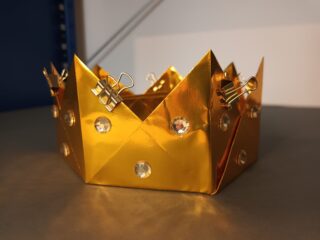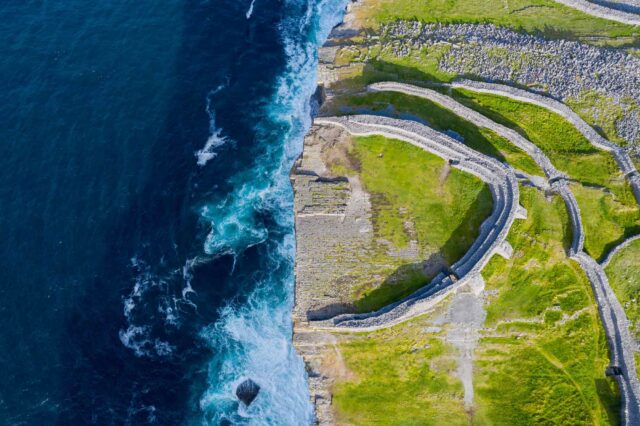Monasteries of the Moy
Growing up in the hinterland of the ancient edifices of Rosserk and Moyne Abbey in Co. Mayo, left a distinct impression on me, and an acute awareness since childhood of ancient Ireland. These ancient ruins sit in a landscape peppered with historic landmarks such as standing stones, the ruin of a 13th century castle across the river and a nearby Holy Well, Tobar Mhuire, housed in a small stone building erected in 1799. This is the landscape that shaped me, inspired my love of architecture and my appreciation of the craftsmanship of the past.
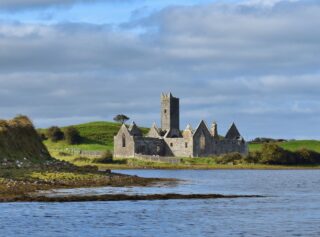
Rosserk Abbey was founded in the fifteenth century by the chieftain of the Joyces, a powerful family of Welsh origin, who settled in Connacht in the thirteenth century. The friary of Rosserk housed a community of friars of the Third Order of St. Francis or the Tertiaries. Unusually this order consisted of married men and women who wished to lead a Franciscan life, but because of their marital status, were not able to join the First Order (friars) or the Second Order (nuns). Prior to the construction of the abbey, the area was called ‘Ros Serce’, named after a miracle working female saint called Searc, a disciple and alleged sister of St. Patrick who resided there. It is speculated that the foundation of the abbey at the Rosserk site occurred somewhere between 1400 and 1441 as the Tertiaries enjoyed wealthy patronage in medieval Ireland. The buildings are grouped around an open cloister, three sides consist of vaulted chambers with a church on the remaining side topped by a bell tower. The kitchen, dining hall and dormitories were located at the first floor level. The abbey has an intact double piscina topped by angels carved in stone, this is a recess with a stone basin for washing sacred vessels used during religious ceremonies. In the late sixteenth century, the abbeys of Rosserk, Moyne and Rathfran, were sacked and burnt by Sir Richard Bingham, English Governor of Connacht. By the 1800’s Rosserk had been abandoned for over two hundred years and walls in many places were on the verge of collapse. In the 1880’s the abbey was taken in to the care of the Commissioners of Public Works who ensured that walls were secured, stonework pointed, and window tracery restored, the original pieces found in the surrounding debris. Works to this National Monument was carried out in Rosserk in 1883, under the direction of the architect, Mr. Thomas Newenham Deane R.H.A.
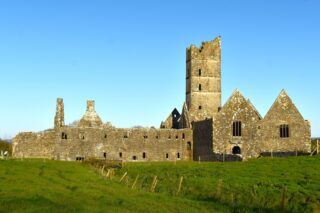
Further down the river towards the ancient village of Killala, sits the larger and imposing ruin of Moyne Abbey. Set further back from the River Moy, Moyne rests in luxuriant green fields, its high tower can be seen for miles around. The Franciscan Friary of Moyne was founded by Mac William de Burgo in 1455, and the building was consecrated in 1462 by the Bishop of Killala. Moyne once possessed a valuable library being a provincial school of the Franciscan order, together with an infirmary and a mill for grinding corn. A well preserved enclosed cloister exists at the heart of the building, an enclosed walkway where the friars prayed and meditated. The more rudimentary elements of monastic life were also accommodated within the abbey walls, including a kitchen and dining hall, sacristy, chapter house and the dormitories. The monastery was burnt in 1590 by Sir Richard Bingham, the English Governor of Connaught. The friars left after suffering persecution at the hands of Bingham, and the lands of the abbey came into the possession of Edmund Barrett. Later it was owned by an English widow, she allowed the friars to return to the Abbey in 1606, where they remained until 1618. Moyne was later owned by the Lindsay family who demolished part of the monastery with gun powder. In 1718, the abbey came into the possession of the Knox family, Francis Knox, the son of William Knox of Castle Rea, took up residence at Moyne after his marriage to Dorothea Annesley. It is said that during the sacking of the abbey, a soldier by the name of Knox killed the last abbot of Moyne. Parts of the abbey were still habitable and Francis re-modelled a wing of the monastery and lived there. After the Knox family left Moyne, the property was bought by the Kirkwood family who are associated with nearby Bartra Island. In the early 1900’s the predecessors of the OPW carried out works to stabilise the structure, access at this time could only be granted by requesting a key from the caretaker’s cottage. Over the last century, since both monasteries passed into the care of the OPW, their constant care and attention over the decades has ensured that these ancient structures have endured and continue to fascinate all those who visit them.
The Education Programme at Dublin Castle
Since launching our Education Programme in May 2023, we’ve sought to enable access to the art collection and history of Dublin Castle. It’s all been a learning process, and one that we’re excited to be involved in.
Prior to the design and build of the Education Room in September 2023, our social media platforms needed to disseminate information in a way that was accessible and engaging. We chose specific paintings, textiles and sculptures to discuss art terminology like chiaroscuro, stuccowork, memento mori and contrapposto in a way that was user-friendly. We grouped specific artworks together under themes like Birds in the Collection, Art Inspired Recipes and L’Influence Française to capture varying audience demographics. We created a Quiz Time highlight on our Instagram page encouraging users to test their understanding of Dublin Castle’s art collection and history. In January 2024, we announced Astrology as the theme of the Education Programme and this has anchored our decisions regarding family-friendly workshops and social media posts throughout the year. The theme has been an enjoyable way to explore the history of the site, encouraging new links to be made between artworks.
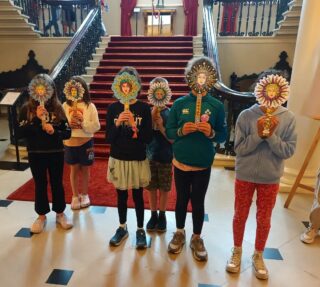
Since May 2023, the Education Team has designed and delivered over 100 individual events as part of our Education Programme. In this year alone, we delivered over 70 free educational events on site, including talks, tours, workshops and demonstrations. In August, we hosted 13 educational events, 11 of which took place during National Heritage Week 2024. It was a wonderfully diverse programme made possible by the talents of the Guiding Team and external collaborators. From Apollo Marks inspired by the stuccowork ceiling of the Apollo Room to Origami Skull Bookmarks inspired by painterly depictions of St. Jerome, we had lots of fun and engaging activities to offer members of the public. We ended theweek on a high, celebrating Wild Child Day with the delivery of a Bird-Box Workshop inspired by those hanging in the trees of the Dubh Linn Gardens. Following the success of the Focal an Lae social media posts and our Turais Trí Ghaeilge, we launched our very first Caint agus Comhrá session in October
2024. This drop-in session will be a monthly event in the Education Room of Dublin Castle. The purpose is to provide a space and framework to speak Irish in a comfortable, relaxed and historically rich setting. It’s another mode of engagement and one that we’re excited to offer as part of our Education Programme. Based on the popularity of our Respond to the Artwork workshops, we’re continuing to adopt ‘slow-looking’ strategies in leading our family-friendly and dementia-inclusive sessions at Dublin Castle. These workshops offer participants space, time and guidance in discussing the art elements as
they relate to chosen artworks in the collection, before completing an appropriate art activity. It’s a format that captures active learning across all age groups, and one that we’re keen to develop in upcoming years. Currently in development is our Educational Video Series, which will provide insights into selected artworks in the collection. These short videos will assist teachers, students and members of the public in learning about the collection in a way that is art-specific and student friendly. We’d like these videos to be part of an ongoing project that complements the Art History curriculum at post-primary level. We recently launched our Painting Pursuit Educational Resource, a trail
that celebrates the artwork of the State Apartments and challenges detectives of all ages to decipher clues hidden in the paintings. It’s been a fun project to lead, and will complement both the ‘Death in the Collection’ tour and ‘Secret Agent’ tour at Dublin Castle. Moving forward, we’re excited about the inclusion of a Portfolio Preparation Course and regular drawing sessions within our Education Programme.
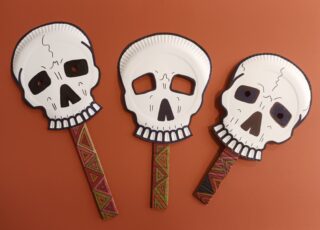
This interest stems from personal experience studying and teaching observational drawing in the classroom setting. Given how fortunate we are to have life-sized plaster cast statues in the collection, there is lots of scope for developing Bargue and Cast Drawing classes in upcoming years. On a final note, I’d like to extend my thanks to the staff at Dublin Castle for their ongoing support towards the work of the Education Team. Since establishing our Programme in 2023, progress has been accelerated through the build of the Education Room, the expertise of the Guiding Team and the contributions of external historians and artists. It’s all been in the pursuit of an engaging programme of events, and we look forward to developing more learning opportunities for people in the future.
